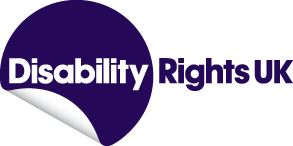Inclusion and Intersectionality: An online resource to support Disabled People’s Organisations (DPOs)
These guidance notes are aimed at Disabled People's Organisations (DPOs) and are divided into different sections for ease of use. They provide an explanation of the key principles with additional hyperlinks for those people wanting in-depth information and real-life examples.
Contents
Understanding Intersectionality
History: DPO’s, the Disabled People’s movement and Diversity
Examples of ways to start being intersectional
Activities for Intersectionality
Understanding Intersectionality
Intersectionality Spotlight:
What is Intersectionality?
- Different people use intersectionality to mean different things.
- The word ‘intersectionality’ can be used to talk about how people who belong to two or more marginalised groups experience discrimination differently from each other and also differently from those who belong to only one marginalised group. We call this ‘multiple marginalisation’.
- People who experience ‘multiple marginalisation’ tend to experience additional discrimination that other people don’t always understand.
- It can also be used to talk about ‘holistic identities’ – thinking about all of the factors that make up who we are as people.
- Intersectionality is a lens to help us think about how different people in the Disabled community experience disability discrimination differently depending on the additional social groups that we belong to.
Why is intersectionality important?
- An important part of social justice for Disabled people is doing all we can to be inclusive of all Disabled people.
- DPOs may unknowingly be creating barriers and discriminating against Disabled people who belong to more than one marginalised community if they don’t think intersectionally.
- Disabled people who belong to more than one marginalised group often report not having access to services that meet their needs.
Benefits to thinking intersectionally as a DPO:
- Being intersectional gives us a better chance of reaching all of the Disabled people in our community who need help – especially those people who experience the most marginalisation or barriers.
- Being intersectional and inclusive can help bring more money to the organisation – because it shows thoughtful leadership, which creates more impact, which is what foundations and commissioners want to see.
- Being intersectional means, we actively create an inclusive Disabled people’s movement which ‘leaves nobody behind’.
- Changing and developing to meet the needs of Disabled people is in our DNA, and this is something we all need to be better at – it creates a stronger community of Disabled people.
Introduction
The Disabled People’s Movement has been vital in challenging discrimination against Disabled people and transforming our quality of life. We know that our movement, our organisations, and our models that promote a better life, like the Independent Living Model and Social Model, have improved the quality of life for Disabled people all around the world. We also know that there is still so much for us to do, and continuing our fight towards equity for ourselves and other Disabled people is more important than ever.
The Disabled peoples’ movement and Disabled people’s organisations (DPOs) have often been criticised for not being inclusive of all kinds of Disabled people. The wonderful thing about ‘intersectionality’ as a concept and focusing more on ‘inclusion’ is that committing ourselves to ‘getting it right’ helps us to work with more Disabled people, helping them to live their life the way that they want to – achieving choice and control for everyone, in whatever way that is meaningful to them.
The word ‘intersectionality’ can sometimes be confusing because many people use it to mean different things. It can feel very tempting to want to understand how to ‘do’ intersectionality, but it’s important to understand where the word comes from and why it is important for Deaf and Disabled People’s organisations and the movement more broadly. That is why, in this section, we look at:
- The history of the Deaf and Disabled People’s movement and Intersectionality
- Different definitions of Intersectionality
- Using Intersectionality to help understand Identity
History: DPOs, the Disabled People’s Movement and Diversity
In the 1960s and 1970s, many movements fighting for better rights for marginalised people developed simultaneously. We had the ‘feminist’ movement, the ‘civil rights movement, the ‘LGBTQI+ rights movement, and the Disabled people’s movement. These movements became known as ‘single issue’ movements and have been criticised for not representing the most marginalised members of those communities.
For example, ‘Second Wave’ feminism has been criticised for representing the needs of white, middle-class women but not representing the needs of women of colour, working-class women or Disabled women very well. Black women later criticised the civil rights movement for representing the needs of Black men. ‘Single issue’ movements sometimes cause additional discrimination or create more barriers for some of the most marginalised people in the communities that they are fighting for because, as human beings, we don’t live ‘single issues’ lives. For example, a black Disabled woman can’t just be ‘Black’ when she is in an anti-racist space or be ‘only Disabled’ when she is in a disability justice space. It can often be a very painful experience to be excluded from a space that is supposed to exist to represent and understand you and your needs.
This is also a criticism of the Disabled People's Movement that we unknowingly exclude Disabled people who face multiple forms of marginalisation by not understanding the issues that impact them and the lives that they live. The language of intersectionality and the framework that it gives us helps us to think through and understand some of these issues in more detail.
Definitions
The Original Definition
Kimberlé Crenshaw, a Black woman, a lawyer and an academic, first introduced ‘Intersectionality’ as a term – she is. She describes how her experience of ‘single issue’ politics, as we talked about above, in society, but also in law, made it difficult for black women to receive justice for the discrimination that they faced.
She introduced the idea of intersectionality to explain the compound impact of Racism and Sexism on Black women’s experiences of discrimination. The term ‘intersectionality’ was used to describe the specific experiences of Black women whose lived experience was defined by living at the ‘meeting point’ of racism and sexism – and that to be inclusive of their experiences meant working differently.
Although the term ‘intersectionality’ has evolved in its meaning, we need to understand its original meaning for two reasons:
- Kimberlé first coined this term to speak to Black women’s experiences, and we mustn't forget or ‘erase’ where this term came from.
- While the term ‘intersectionality’ has become a more general term for thinking about how all of our identities come together to create the person that we are – the part where we think about the ‘compound impact’ of each marginalised identity and how this creates a specific experience of marginalisation is very important.
DPOS need to understand the original meaning of this term because it relates specifically to how different Disabled peoples’ experience of disability itself will vary based on their gender, ethnic origin, sexual orientation, and many other social groups that they belong to. So, to advocate for Disabled people means to understand and include the many ways that Disabled people live.
Different Definitions of Intersectionality
Below are some additional definitions of intersectionality that you can read to understand how people define the term.
“A framework of understanding developed by Kimberlé Crenshaw that describes how different systems of inequality, like racism, sexism, and ableism, intersect to create unique experiences of discrimination and oppression… Intersectionality recognises that the culmination of identities creates specific and varied barriers to inclusion.” (The Equality Institute).
“Intersectionality is an analytical framework for understanding how a person's various social and political identities combine to create different modes of discrimination and privilege. Intersectionality identifies multiple factors of advantage and disadvantage.” (Anne Sisson Ruyan).
“The concept of intersectionality describes how systems of inequality based on gender, race, ethnicity, sexual orientation, gender identity, disability, class and other forms of discrimination “intersect” to create unique dynamics and effects.”(Centre for Intersectional Justice).
How organisations use the term:
Since the term ‘intersectionality’ came to be used more widely, the meaning has changed a little. Some organisations use it to think holistically about people’s identities. It is a way of thinking about ‘what makes up an entire person’ and their experiences.
This way of thinking about intersectionality can sometimes distract from its political significance. However, it is important to understand that our work can only be intersectional if we are thinking about how multiple marginalised people experience the world differently based on the intersection of the inequalities they face.
Being Intersectional
There is no shortcut to learning to be intersectional. It is a way of thinking about inclusivity, an approach, or a frame of mind, rather than a ‘thing’ you must do. Below, we explore some steps that you might take to help you:
Examples of ways to start being intersectional
Thinking Exercises
- Start by thinking about the different aspects of someone’s life that may impact their experience of disability. You can use the Intersectionality wheel to help (see below).
- Learn about power and privilege in these different groups – you can use the power and privilege wheel to help (see below).
Research
- Desk research: Watch videos, listen to podcasts and learn about the experiences of people in different groups – what is the impact of their intersectionality? How do different experiences impact different people?
Networking
- Pay DPOs who are doing this work well to help you start, or do a ‘skills swap’ if you can’t afford this.
- Talk to the Disabled people in your community who experience multiple marginalisation and understand how it works in the real world.
Organisational Evaluation
- Do a critical evaluation of inclusivity in your organisation
Enhancing Strategy
- Co-produce ways to build intersectionality into your services.
- Create a strategic approach / build an intersectionality policy
Paying Experts with Lived Experience
- If you don’t have time for this, consider how you might advocate for support. Could you work with other DPOs? Can you afford Disabled consultants? Can you lobby funders or the local council? Can you source organisations that might deliver training or do a diversity audit pro bono?
Remember:
- Start with online resources and research. It is not the job of people who experience multiple marginalisations to educate you on intersectionality.
- Once you understand intersectionality and the key issues, you can begin to hold conversations.
Activities for Intersectionality:
The intersectionality wheel
The intersectionality wheel below helps us to visualise some of the different aspects of who someone is that might impact their disability journey.
You can use this as an activity for yourself or in a staff group:
- Use the red wheel to define the different terms, and think of some examples. If you’re unsure, use Google to search for these definitions.
- Now use the blue and grey ‘petals’ to think about how each petal might impact someone’s experience of disability.
- Think about how each example you have used might change over time and with age.
This activity helps us understand what different terms mean and how much we know about each issue.
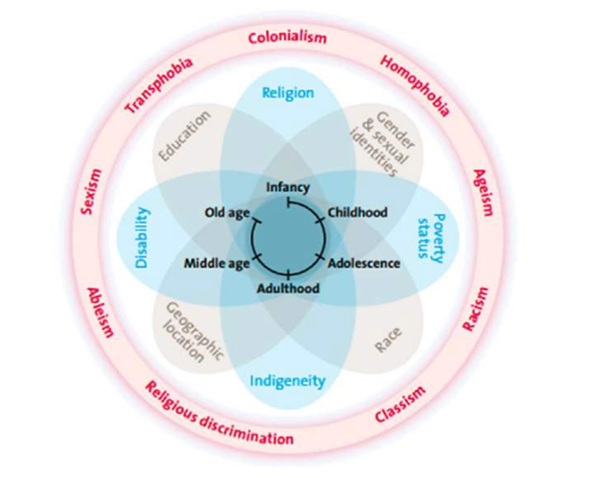
Image from: UN Women/ UN Partnership on the Rights of Persons with Disabilities – Intersectionality Resource Guide and Toolkit.
This wheel helps us to understand how our disability/the needs of the Disabled people that we work with might change depending on which time of our life we are in, the different aspects of our lives and the different types of disadvantages that impact our experience of disability.
This ‘wheel of power and privilege’ can also help us to think about our relationship to power and privilege:
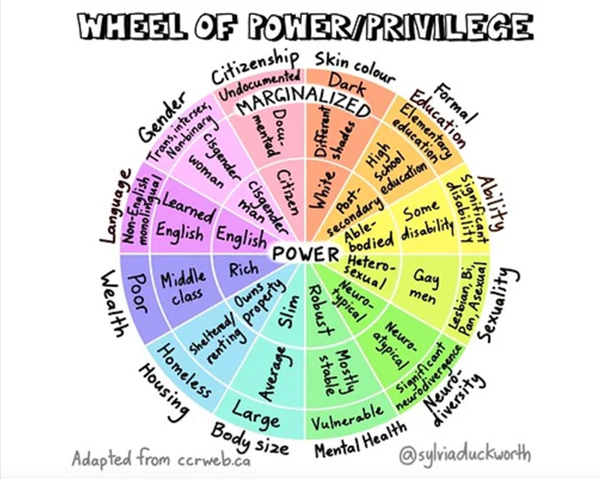
Running Sharing Circles
If your DPO has members from different backgrounds, but you are unsure how their backgrounds/identities may impact their experience of disability, try running a sharing circle to learn more.
Note: Ensure you have a basic/intermediate understanding of intersectionality and the issues involved before you do this so you’re not relying on people to explain everything to you from scratch.
It is important that sharing circles are run effectively, are safe spaces and that safeguards are in place for any unexpected triggering. You could, for example, hire a counsellor for this work, who is on hand to help.
More information: How to run a sharing circle
More information: Holding a sharing circle
More information: The value of sharing circles
Additional Online Resources
Videos:
Written/Digital:
- United Nations’ Intersectionality Guide and Toolkit
- Inclusion London’s ‘With Us’ Intersectionality Project Resources
Blog Resources:
- What is intersectionality, and why does it matter?
- Building Equity – Bringing our whole selves to work
Podcasts
There are lots of podcast episodes on Intersectionality and Disability. Once you have a platform to listen to podcasts, you can click on the search function, type in ‘intersectionality + disability’, and choose which podcasts you would like to listen to. For Deaf and hard-of-hearing colleagues, some podcasts come with transcriptions that you can read.
Glossary
Marginalisation – Marginalisation means to treat a person or social group as less important – intentionally placing barriers in their way or knowing barriers exist and not removing them. This often results in exclusion from services and social life.
Multiple Marginalisation – If someone experiences multiple marginalisation, it means that they belong to more than one group that experiences marginalisation. Some examples of groups that experience marginalisation are Disabled people, refugees and asylum seekers, people of colour, and people with LGBTQI+ identities. So to experience multiple marginalisation would be to belong to two marginalised groups at the same time – for example, to be Black and Disabled.
Compound Impact – Compound impact means how something adds up over time.
Being Intersectional
Written in partnership between:
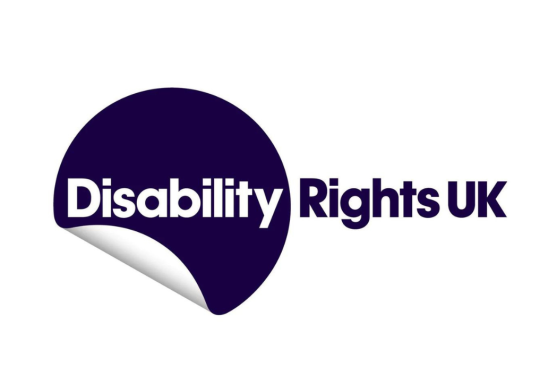
Disability Rights UK is the UK's leading organisation led by, run by, and working for Disabled people. They work with Disabled People's Organisations and Government across the UK to influence regional and national change for better rights, benefits, quality of life and economic opportunities for Disabled people.
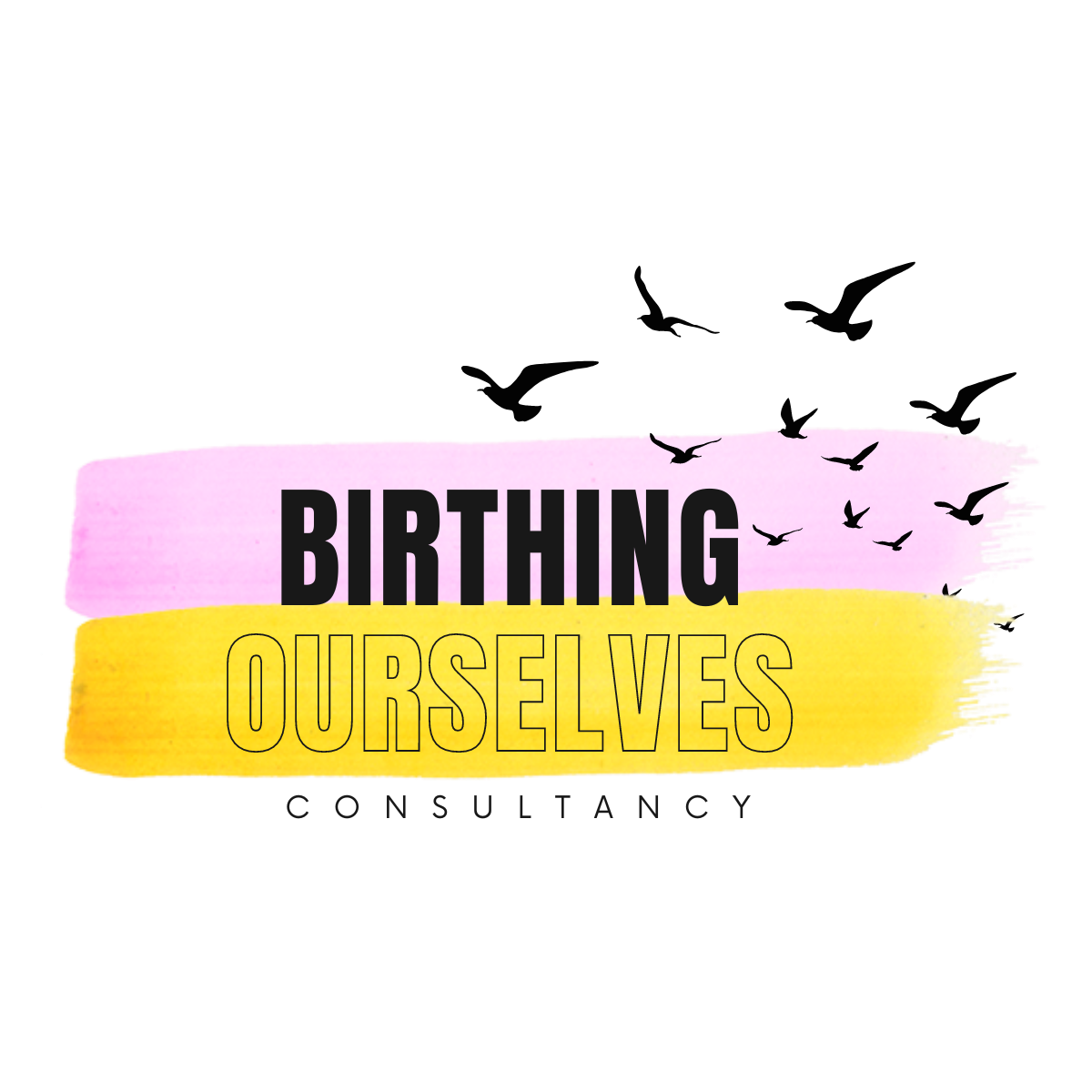
Amanpreet Ahluwalia-Hinrichs, founder of Birthing Ourselves, has 16 years of experience in social justice and community leadership development – this includes many years of having a leadership role in and working with DDPOs. Aman’s vision for Birthing Ourselves is to build a world where all leaders interested in social justice can access the tools, skills, training and relationships they need to achieve significant, transformational change. To find out more, visit wwww.birthingourselves.co.uk or e-mail Aman at aman@birthingourselves.co.uk
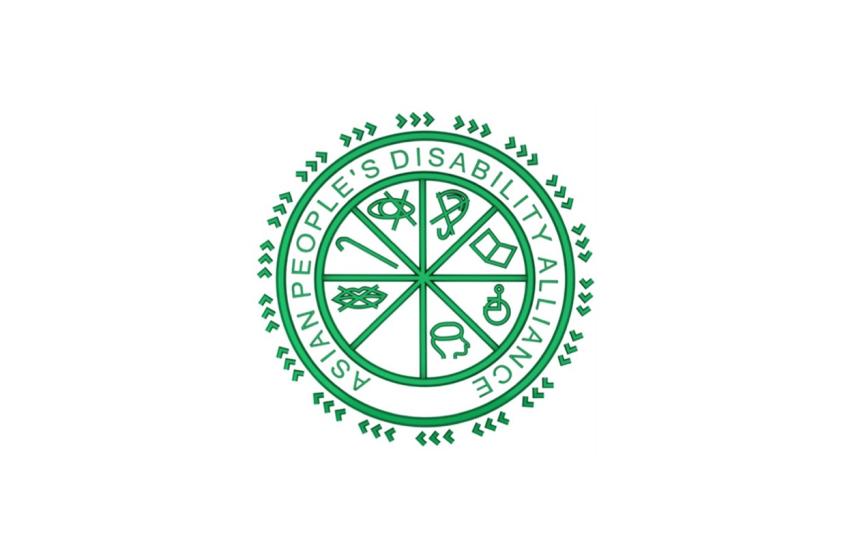
The Asian People's Disability Alliance (APDA) is London based DPO that provide culturally appropriate and bespoke sensitive day care and home care support and services to Disabled, elderly and other isolated people.
